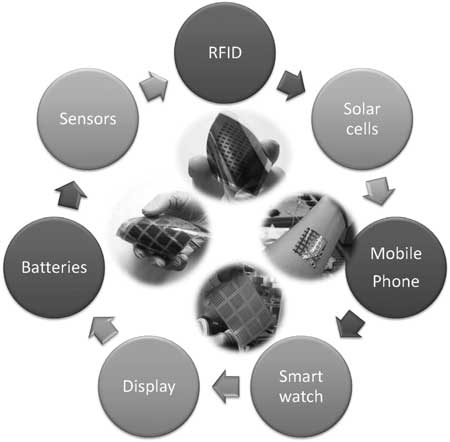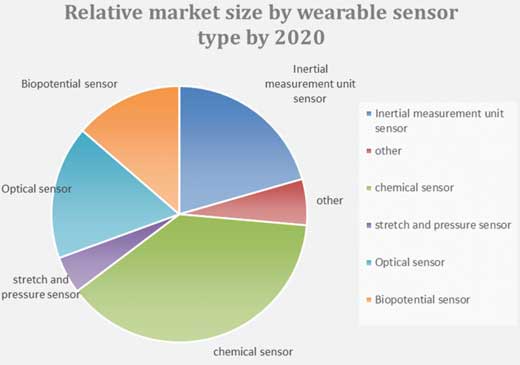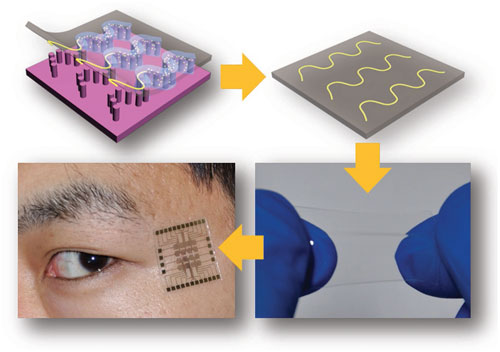| Posted: Jul 07, 2017 | |
Flexible sensors |
|
| (Nanowerk Spotlight) Flexible sensors hold great promise for various innovative applications in fields such as medicine, healthcare, environment, and biology. | |
| Considering that most wearable systems, healthcare electronics, and laboratory-on-a-chip testing tools can be expected to come into contact with arbitrarily curved interfaces, the flexibility of sensors is essential for improving their interactions with target systems and improving the reliability and stability of the tests. | |
| Over the past decade, the development of flexible and stretchable sensors for various functions has been accelerated by rapid advances in materials, processing methods, and platforms. For practical applications, new expectations are arising in the pursuit of highly economical, multifunctional, biocompatible flexible sensors. | |
 |
|
| Schematic illustration of flexible electronics in development today across a broad range of applications. (Reprinted with permission by Wiley-VCH Verlag) | |
| A new review article in Advanced Materials ("An Overview of the Development of Flexible Sensors") aims to illustrate various types of flexible sensors. | |
| Rather than summarizing the huge body of relevant previous work, the authors select noteworthy work that may suggest crucial future trends of flexible sensors. They summarize the recent stateof-the-art flexible electronics currently employed as flexible light sensors, flexible pH sensors, flexible ion sensors, and flexible biosensors. | |
| The selections of materials and the fabrications of devices are included in every part. The authors also provide a detailed description of engineering technologies with an emphasis on flexible sensor fabrication. | |
| They then present market analysis on the world sensor market, printed sensors, and wearable sensors. | |
 |
|
| Relative market size by wearable sensor type by 2020. (© IDTechEx) | |
| Numerous opportunities and challenges remain in the future research and development of high-performance flexible sensors. | |
| For flexible sensors attached to the human body or its organs, the biocompatibility of the active materials and flexible substrates, including long-term toxicity analyses, is a crucial research area, especially for invasive applications. | |
| Innovative utilization of device designs, materials, assembly methods, and surface engineering, as well as interface engineering, can address these challenges. The development of new materials for active layers, substrates, and conductive layers can give rise to soft, stretchable sensors; this emerging paradigm can extend the scope of current technologies for different sensing functions. | |
| Improvement of both flexibility and sensitivity is another challenge for state-of-the-art flexible sensors. The development of novel elastic materials for flexible and stretchable substrates, geometrical electrode designs, combinations of molecular designs in organic materials, and utilization of conceptually novel materials could optimize the trade-off between sensitivity and flexibility. | |
| High-density sensor arrays with multiple functions must be integrated for enabling a high spatiotemporal resolution to realize fully functional flexible electronics. Take for example human micromotion sensor (read more here: "Nanocurve-based sensor reads facial expressions"): | |
 |
|
| Schematic illustration of a nanoparticle curve array printed to flexible electronic devices and adopted to multi analysis for skin micromotion sensing. Nanoparticle curve arrays were printed on the PDMS substrate by pillar-patterned template induced printing with sliver nanoparticle ink. These flexible electronic sensors can be directly attached to human facial skin, and perform real-time multi analysis for skin micromotion monitoring. (Reprinted with permission by Wiley-VCH Verlag) | |
| Nevertheless, raising the density of sensors leads to increased crosstalk. Reducing the size of sensors diminishes the amplitude of signals. These problems can be addressed by connecting each sensor with active devices such as transistors to enable local signal amplification and transduction. | |
| The development of sensors is the enabling technology for Internet-of-Things (IoT). A surge in IoT provides plentiful opportunities for spreading out of flexible sensors with reconfigurable shape and size. | |
| Thanks to their light weight, thinness, and robustness, flexible sensors can be seamlessly integrated onto any surface to provide users more improved avenues, which is difficult to realize in conventional electromechanical sensors. | |
| With the development of polymers, oxides, printing technologies, and CMOS technologies, flexible sensors will unlock a completely novel set of IoT products. The achievement of these fantastic sensing applications will bring us closer to the new electronic era promised by flexible sensors. | |
 By
Michael
Berger
– Michael is author of three books by the Royal Society of Chemistry:
Nano-Society: Pushing the Boundaries of Technology,
Nanotechnology: The Future is Tiny, and
Nanoengineering: The Skills and Tools Making Technology Invisible
Copyright ©
Nanowerk LLC
By
Michael
Berger
– Michael is author of three books by the Royal Society of Chemistry:
Nano-Society: Pushing the Boundaries of Technology,
Nanotechnology: The Future is Tiny, and
Nanoengineering: The Skills and Tools Making Technology Invisible
Copyright ©
Nanowerk LLC
|
|
|
Become a Spotlight guest author! Join our large and growing group of guest contributors. Have you just published a scientific paper or have other exciting developments to share with the nanotechnology community? Here is how to publish on nanowerk.com. |
|
